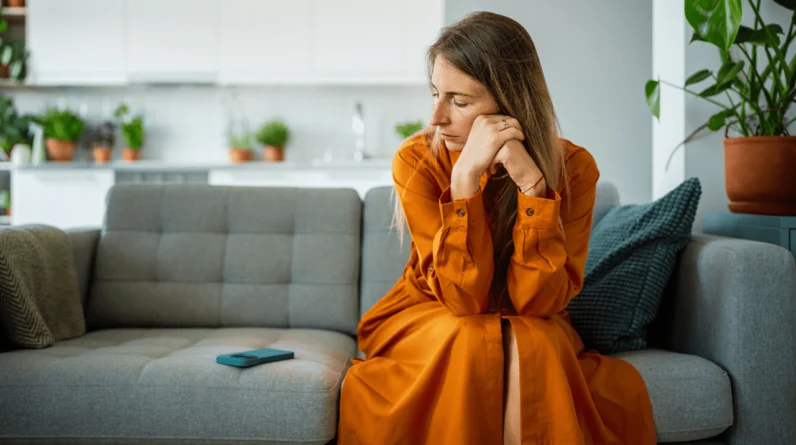
Social media is a wonderful tool for connection and opening our hearts and minds; it’s also a great outlet for creativity, gathering information, learning, and doing business. However, if we don’t manage it well, it can also be highly detrimental to our mental health and well-being.
We all know that mindlessly scrolling through YouTube, Instagram, Snapchat, Twitter, TikTok, or Facebook can leave us feeling drained and waste hours of our week and, ultimately, immeasurable amounts of time in our lives.
We also know that the challenges around social media are prevalent and continue to increase, with countless studies emphasizing the drastic negative impact.
One study showed that 58% of Americans say social media negatively affects their mental health. The most common negative mental health impact of social media use is anxiety (64%), followed by depression (56%), dissatisfaction with life (52%), fear of missing out (52%), and body image issues (51%).
In a study commissioned by ExpressVPN, 86% of Generation Z revealed that social media negatively impacted their happiness and significantly impacted other areas of their mental health, including self-esteem, self-image, anxiety, loneliness, and depression.
Stars like Selena Gomez, Camila Cabello, and Ed Sheeran have all taken social media breaks over the years to protect their mental health and wellness. Most recently, Tom Holland announced on Instagram that he was taking a break from social media for his mental health:
“I find Instagram and Twitter to be overstimulating, to be overwhelming. I get caught up and I spiral when I read things about me online and ultimately, it’s very detrimental to my mental state.”
So how do you get all the benefits without all the harm?
Here are 5 common problems with social media, alongside strategies to protect your mental health and well-being.
Problem #1: You’re Comparing Yourself to Others.
This seems to be the most common, yet unconscious, problem with social media. You scroll through, often feeling envious of what others are doing and what you’re not doing. We’ve all been there. You see a friend set up her kid’s first day of school – complete with the chalkboard, a perfect breakfast, and all their cute school supplies on the kitchen table. Meanwhile, you’re struggling to get your kids out the door.
Or you see a friend finish that 5K you’ve wanted to run for ages – and while you’re proud of him, you’re also feeling bad that you haven’t even started training. Maybe you see stories from a colleague on vacation and feel resentment that you haven’t had one in years.
Solutions
First, remember this. You are comparing your entire life to their highlight reel. You’ve likely heard this before, but it bears repeating. Keep in mind that what you see isn’t the whole picture.
I remember when I was out on the river for the day with a friend and our families, and her kids were having a major meltdown. Everyone was frustrated and it was a mess. What pops up a few hours later on her Instagram feed? A gorgeous photo of her and her family having the BEST time. Big smiles, a gorgeous day, and lots of fun. Social media is full of picturesque moments that don’t always represent the full reality.
I’m not saying we can’t be happy for our friends and their amazing experiences – we just need to remember that we’re seeing one nanosecond of a bigger picture. Zoom that out across our lives. We all have ups and downs, good moments and bad, and the problem with social media is that it often only captures a small, carefully curated snapshot.
Thomas Edison once said,
“Comparison is the thief of joy.”
When we compare ourselves to others, there will always be someone greater or lesser than ourselves. There will always be someone doing more or less.
In order to stop comparing yourself, and ultimately feeling bad, envious, judgmental, righteous or critical, you must get very clear on what is important to you. The only way to stand strong in yourself and not get rattled by those around you is to stand strong in your values, your ideals, your dreams. If you don’t already know your values, I highly recommend you spend some time to self-reflect on what’s most important to you and what you want for your life.
The Subtle Art of Not Giving a F*ck by Mark Manson is another great place to start. Because what matters most is that you are on track with your life, your goals, your plans and what is most important to you. When you are grounded in that, the things that everyone else is doing won’t bother you so much.
However, if they still do, there’s a reason. Sometimes the envy or disappointment you feel when comparing yourself is actually a red light flashing on something that you want or need. If you’re noticing that you’re envious of friends enjoying new adventures – maybe it’s a signal that you need a new adventure, too. If you’re envious of the lovey-dovey photos your friend is posting with her wife, maybe it’s your cue to work more deeply on your relationship.
Use those feelings as motivation to meet your own needs – not as a gesture to match their happiness, but to identify what may be missing in your life. Think critically about what you’d like to achieve and go out and get it!
Problem #2: You’re Wasting Time.
You pick up your phone to check a text and, next thing you know, you’ve been sucked down the social media rabbit hole. You’re now mindlessly scrolling through social media. And time goes by…how much time?
According to one survey, the average amount of time spent on social media worldwide is set to hit two hours and 27 minutes a day this year. This is the highest number ever recorded.
Got kids? On average, tweens (ages 8 to 12) spend five hours and 33 minutes and teens (ages 13 to 18) spend eight hours and 39 minutes on social media. That is literally more than a full-time job!
In addition, the average American checks their phone 96 times per day, or once every ten to 12 minutes. We touch our phones up to 2,617 times per day and unlock our phones 150 times on average. For heavy users, that number can reach over 5,000.
Solutions
Let’s be clear: it’s normal – even beneficial – to surf the web or use social media. But be selective and strategic about how to use your time.
Set a time limit. Findings from a study by the University of Pennsylvania strongly suggest that:
“Limiting social media use to approximately 30 minutes per day may lead to significant improvement in well-being.”
While you may not be able to limit your – or your kids’ – social media to 30 minutes a day, you may be able to reduce it just through awareness. The same study showed that just being more mindful of your social media use can have beneficial results on your mood and focus.
Do you know how much time you’re spending on social media? I think you’ll be surprised. You can track your social media on your phone. Just use a third-party app or go to your phone’s Settings > Screen Time > See All Activity and scroll down until you see the number of pickups.
I encourage you – right now – to check out your average daily use. What could you accomplish in the two, three, or four hours you are spending a day on your phone? Consider how often you are saying, “I don’t have time for that,” when in fact you could pursue those goals instead of choosing social media.
Imagine if you consciously choose to dedicate some of your social media time to reading a book, taking a class, spending time with family, hitting the gym, or setting up that new business you’ve been thinking about. What impact would that have on your life, your success, your relationships, health and well-being if you dedicated just half of your social media time to your real life?
What about your much-needed rest? How much time do you spend mindlessly scrolling while in bed when you should be sleeping? In fact, the blue light keeps us up and the stimulation makes your brain stay awake when it should be getting rest and recovering.
Your kids have a bedtime; your phone needs one, too. Leave it in another room to charge while you recharge. If you can’t reach it, you can’t be on it. At our house, we have a charging station where all the phones go every night.
Problem #3: You Feel Isolated and Alone.
Funny how you can spend so much time connected and yet feel so disconnected simultaneously. Why? It’s not usually real connection.
Studies show that people today feel more isolated and alone. We feel left out, disconnected, and have FOMO. During Covid, using our phones for connection was critical – but even then, studies show that it had a negative impact.
Solution
Allow yourself to make and foster real connections. Use that time we talked about reclaiming to set up a friend date once a week.
Attend a local networking event, industry luncheon, or continuing ed class. Next time you reach for your phone to start scrolling, instead, send a text to a friend you haven’t talked to in a while or call a loved one. You’ll soon see positive results.
Problem #4: You’re Mindlessly Scrolling.
How often have you gone to your phone to look for something – a text, a phone number, a picture – and then it’s 20 minutes later? Often, the problem is not that we are simply using social media; the problem is that we are using it with little to no intention. It’s filling time – and very smart algorithms are taking you on their own journey.
Solution
Be mindful. What is mindfulness exactly? No, I’m not asking you to meditate (although that’s not a bad idea either). Mindfulness is “the quality or state of being conscious or aware of something.” Each time you pick up your phone, think about what you want to do and why. Are you bored or do you have something to achieve?
Maybe it’s become a habit to turn to your phone any time you have a spare moment? Break the Habit Loop. In his book, The Power of Habit, Charles Duhigg shares the habit loop.
There are three parts to the Habit Loop:
- The Cue: this is the trigger for the behavior to start. This could be a location, time of day, emotional state, person, or in the case of your phone, likely a notification or buzz.
- The Routine: this is the behavior itself. Getting on your phone, checking the text, or logging onto social media and starting to scroll.
- The Reward: This is what your brain gets out of it. In the case of social media, it’s likely the dopamine hit. But it could also be a feeling of connection, escape from the real world, or laughter. Only you can identify the reward you get – what do you feel from scrolling through social media?
If you can diagnose your habits, you can change them. Think about what your “cue” is. If it’s a notification, turn off notifications on your phone for anything that isn’t essential. Maybe your cue is feeling stressed out – and social media is a way to escape. Perhaps when you feel stressed, you can take a quick walk or use your phone for a brief meditation – then you get the reward – a reduction in stress and a moment of relaxation.
Habits can be hard to break, but if you’re aware of them, you can break any habit by using this process.
Problem #5: You’re Doomscrolling.
Doomscrolling is mindlessly scrolling through negative news articles, social media posts, or other content-sharing platforms. Essentially, it’s reading one negative story after another. While the term has been around since 2018, it became more of a common practice over the last few years and through the pandemic.
Clinical psychologist Dr. Amelia Aldao warns that doomscrolling traps us in a “vicious cycle of negativity” that fuels our anxiety.
“Our minds are wired to look out for threats,” she says. “The more time we spend scrolling, the more we find those dangers, the more we get sucked into them, the more anxious we get.”
That grim content can then throw a dark filter on how you see the world, says Aldao.
“Now you look around yourself, and everything feels gloomy; everything makes you anxious. So you go back to look for more information.”
Think about this: Our minds were not designed to know all the bad things that are happening in the whole world at any given point in time. Even 100 years ago, people got their news from newspapers or community members. Two hundred years ago, people only knew what was happening in their immediate circle of influence.
Our minds were designed to protect us from immediate threats and dangers – and before social media, we only knew about those things that directly affected us.
Now, we know about EVERYTHING. We are exposed to all types of traumatic and disturbing content daily. And the worst part is, most people can’t discern between what is fake or real, sensationalized or embellished for likes, views, and engagement. No wonder we are experiencing more stress and anxiety!
Solution
Consciously curate what you are consuming.
When you scroll, pay attention to how you feel. Pause and notice your energy. What makes you feel joy, connection, love, and spark awe or wonder? What makes you feel envious, judgmental, sad, angry or less than? Then, take action by removing or unfollowing accounts that make you feel horrible, envious or worried.
Now, add some positivity to your social media feed; seek out things that make you feel happy and secure, and follow people with an optimistic worldview. Love puppies? Into good food? Flowers make you happy? Need a good laugh? Follow accounts that bring you joy or give you a sense of peace and positivity about the world.
Bottom line
The key is not to stop using social media altogether. The key is to take control of how you use it.
Think critically about how you can use the power of social media to expand and improve your life. Identify the problems you are facing from misuse and overuse and implement strategies such as these to reduce their negative impact and help you reclaim your mental health, well-being, and joy.







